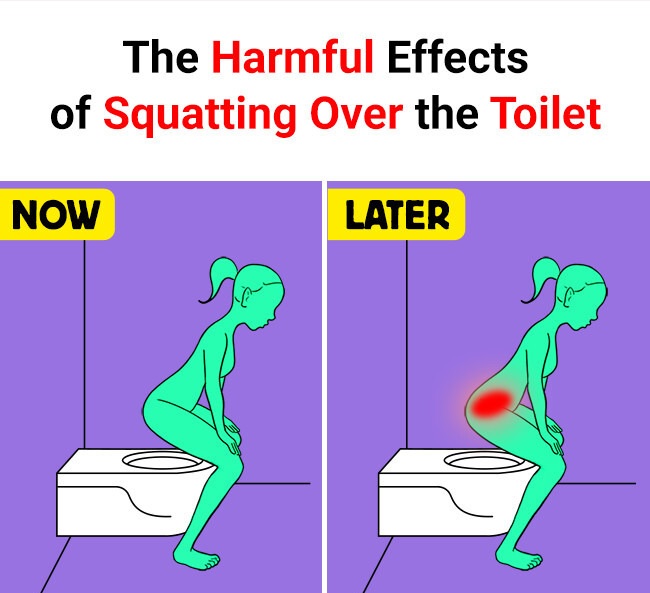Let’s be honest—public restrooms are rarely the picture of cleanliness. So, when the need to go arises in an unfamiliar or less-than-sanitary setting, most people are faced with a common dilemma: either hold it in or avoid touching the toilet seat by hovering above it. While hovering might seem like a practical and hygienic solution, it turns out that this habit can have some negative effects on your body, especially when it becomes a regular practice.

Specifically, your bladder and pelvic floor may suffer from repeated squatting or hovering instead of sitting properly. When you hover over the toilet, your pelvic floor muscles don’t get the chance to fully relax. In fact, studies have shown they remain up to 40% engaged. That tension may not seem like a big deal at first, but it can interfere with your body’s natural ability to empty the bladder completely. Over time, this creates a variety of health concerns that many people never associate with how they use the restroom. One of the major issues is the increased risk of bacterial growth. When your bladder doesn’t fully empty, the leftover urine becomes an environment where bacteria can grow and thrive.
This is particularly problematic for individuals who hover frequently, as incomplete urination becomes a recurring problem. That bacterial buildup can lead to urinary tract infections (UTIs), bladder irritation, and other uncomfortable symptoms. If you often feel a burning sensation while urinating or find yourself needing to go again just moments after leaving the restroom, it could be a sign that your bladder isn’t emptying fully due to poor posture while urinating. That nagging “I still have to pee” feeling isn’t just in your head. It’s your body trying to tell you something. When urine remains in the bladder, it puts pressure on the bladder wall, which in turn triggers the sensation of needing to urinate more frequently—even if there’s very little left to expel. Over time, this can become frustrating and disruptive, especially if you’re constantly seeking out a restroom without ever feeling fully relieved. Another concern is the impact hovering has on your bladder muscles.
When you consistently urinate with partially engaged pelvic muscles, you start to build a kind of muscle memory that teaches your body not to fully relax during this process. Eventually, this can weaken your overall bladder function, making it harder to control urgency and increasing the chances of experiencing bladder leaks or overactive bladder symptoms. The good news is that there are smarter and healthier alternatives if you’re worried about the cleanliness of public toilets. One of the best options is to practice a full squat, similar to the deep squat position used in some cultures with squat toilets.
This posture allows your pelvic floor muscles to relax fully, encouraging a more complete bladder release. In fact, people in countries that primarily use squat toilets tend to report fewer urinary problems because their body position during urination is more aligned with natural function. Another easy solution is to carry disposable toilet seat covers or disinfectant wipes. These simple tools let you sit on the toilet seat without worrying about germs, and allow your body to do what it’s meant to do—empty your bladder completely and without added strain. Sitting down not only feels better, but it’s also significantly better for your long-term pelvic health. So while hovering may seem like the safer or cleaner option, it can actually work against your body’s natural processes. By keeping your muscles tense and preventing full relaxation, you risk a range of issues from infections to weakened bladder control. Making the effort to sit properly, with the help of sanitary tools if needed, is a small change that can lead to big improvements in your health and comfort. The next time you’re tempted to hover, think twice—your bladder and pelvic muscles will thank you for choosing a better approach.





